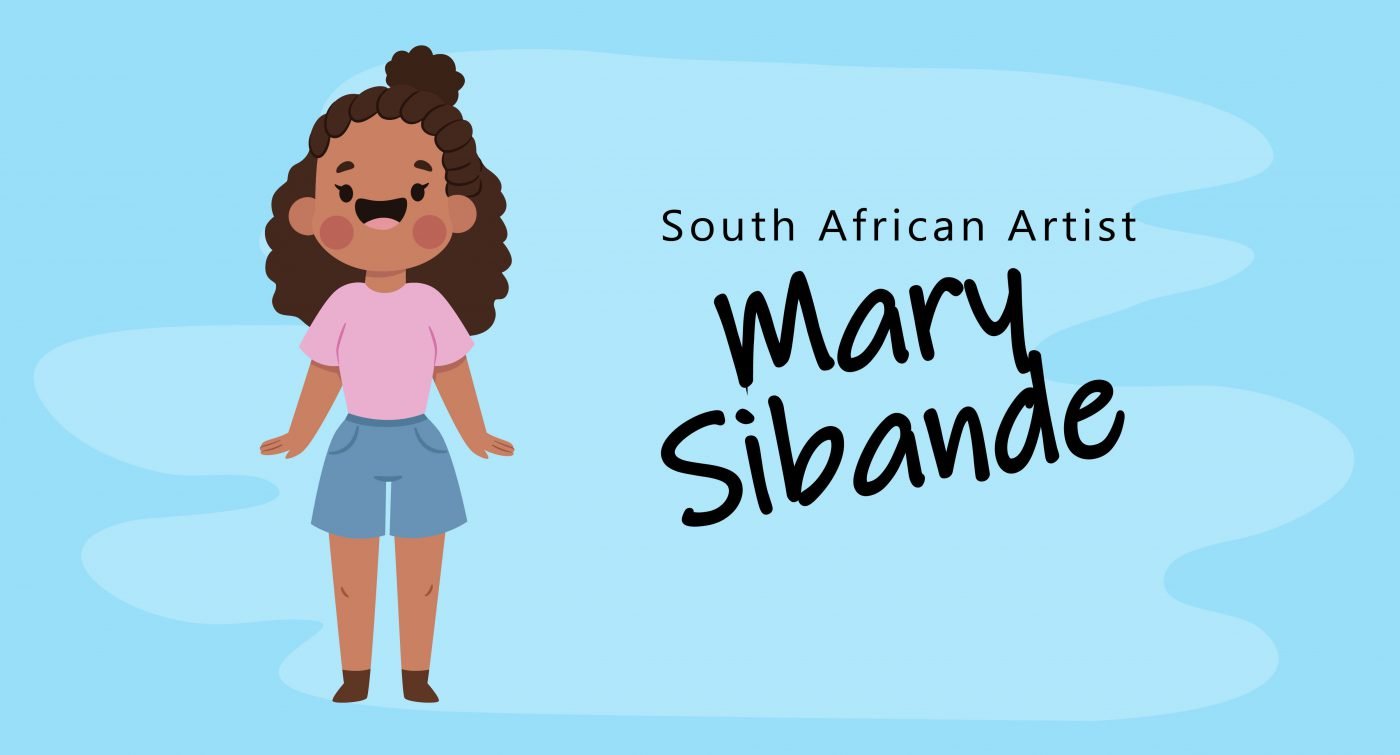No products in the basket.
Art History
Who is the fantastic South African Artist Mary Sibande? And the 4 concepts you have to know to truly understand her art.
In order for you to truly understand the artwork of Mary Sibande we need to backtrack into history a bit and I need to explain a few important concepts to you.

What do you see? What work does this woman do? Is her dress African? What is her ethnicity? What colour is the dress? Why is she knitting a Superman outfit? Is it for her or for someone else? What on earth is going on in this artwork?
Some of the concepts we need to revise and look at is:
- colonialism
- Apartheid and it’s economic structure
- freedom from Apartheid, and the first democratic election in South Africa in 1994
- the mantra “work hard and you will succeed”
Colonialism
What is colonialism? Colonialism occurs when one nation subjugates another nation often forcing their culture and their language upon the local population. During the Age of Discovery a lot of European nations wanted to expand their influence by setting up colonies.
These countries included Spain, Portugal, Germany, the Netherlands, Britain and France. The motivation for colonialism could often boil down to these three things: God, gold, and glory.
God in the sense that European colonisers believed that it was their duty to spread Christianity and its teachings.
Gold in the sense that colonisers wanted to find trading routes and untapped natural resources.
And glory in the sense that there was a bit of competition between the European nations to see who could set up the most colonies.
Colonialists will arrive and observe the native culture of these new countries and see “mmm you don’t dress like me, you don’t talk like me, you don’t act like me, and you don’t believe like me, but really actually you should.”
The settlers would start moving into the country and set out forms for them to start cultivating the land. To do all the hard manual labour of farming they really needed farm workers and this is the whole origin of the entire slave trade and the start of segregation, the separated-ness between black and white.
It’s important to note that this happened all across the world not just here in South Africa, but in America, in the Caribbean, in Africa, in India, everywhere the colonialists settled.
Now as with all things in life Colonialism wasn’t just bad, there’s always a positive and negative in every single situation. Host countries often invested into their colonies, into areas such as infrastructure and trade. Sometimes they would share their medical practices and technology as well. Technology such as guns, transportation, and agricultural instruments. These are the positive side effects of colonialism.
The negative side however is massive slave trade, landlords, land possession and enforcing culture on another culture. Eventually slave trade led to segregation which led to Apartheid. This brings me to point number two: Apartheid and its economic incentives.
Apartheid’s Economic Incentives
It’s important to realise that Apartheid’s architecture was because the white Afrikaners needed cheap labour for mines. This created an interesting dynamic in the black culture where families would often live in their homeland, for example, the Transkei, and the father has to leave to go and live in Johannesburg to get work on the mines, and families and kids were often abandoned.
Women were often employed as domestics cleaning the large colonialists houses, eventually there was a lot of protest against Apartheid and we see the freedom of Nelson Mandela and our first democratic election in 1994 – yay! This brings me to point number three: freedom.
Freedom
Everybody thought that this new free rainbow nation South Africa was like a magic wand that just could solve everybody’s problems, sadly this wasn’t true and the born free generation, the generation born after 1994, is often disappointed with how South Africa turned out and that not much has really changed. This brings me to my last point, point number four: the mantra of just work hard and you will make it.
The Mantra of ‘work hard and you will make it’ is a myth
This is a mantra that is often punted in modern society, however, it is not true. Melinda Gates argues in her book The Moment of Lift that if this statement was true, the richest people on the planet should be African mamas. They work incredibly hard, fetching water, carrying wood, looking after lots of children.
Look Again at Mary Sibande’s Work

So now that you understand a little bit more about these four concepts: colonialism, Apartheid and its economic motives, the freedom of South Africa, and the mantra of work hard and you will be rich. Let’s look at Mary Sibande’s artwork again. Now what do you see? We are seeing colonialism with a black woman dressed as a maid in a garment of servitude, with a doek on her head and an apron.
We see her wearing the blue dress that is not in an African style, but in a Victorian style, which talks about one culture imposing themselves on another.
We see the failure of the current free South Africa in the fact that we still have a lot of domestic workers and people trapped in poverty. We see that hard work simply isn’t enough.
Where these domestics often care for other people’s kids and then have to go late in the night or only on weekends to attend to their own households and their own children.
But then we also notice something fantastical about it – a big Victorian dress almost like a Cinderella born from the ashes, or an Alice in Wonderland in a dream world, and there’s some hope in this artwork. What is this all about?
Mary Sibande’s Life
Mary Sibande I was born in Barberton in 1982 during Apartheid in South Africa. Like a lot of black children back then she was raised by her grandmother.
She didn’t know her father at all, he was in the SA army fighting the war. She only met him when she was 16. Her mother left for Johannesburg to go and find work as a domestic.
Mary Sibande comes from a legacy of domestic workers. Her great-great-great grandmother was a slave, her great-grandmother was domestic, grandma was a domestic, her mother was a domestic, was she going to be a domestic?
Mary’s mom worked really super hard and she saved whatever little money she had. She saved all this money so she could send her daughter to a good school, she didn’t want her daughter to be a domestic as well. When asked about her childhood Mary says “I had everything I needed and I went to a good high school which was multiracial, many families couldn’t afford to send their kid there, but I was fortunate that my mum was able to, and I guess that also pushed me into a certain direction”
At school Mary really wanted to become a fashion designer so she set off to join her mom in Johannesburg so she could go and study. First she did a diploma in Fine Arts at the Technicon of Witwatersrand in 2004, and then she obtained a BTech degree from the University of Johannesburg in 2007.
Because of her mom being a domestic and her grandma and her great-grandma she really wanted to pay homage to the life of a domestic worker and she created an alter ego called Sophie.
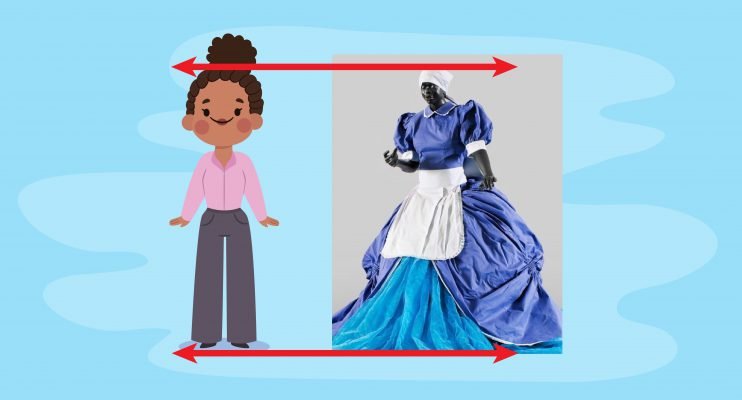
Sophie is a domestic and she is a life-size replica of Mary Sibande’s body. Back at university when Mary originally started sculpting, Sophie was quite a small little figure and she started making the sculptures bigger, bigger and bigger, and eventually concluded that life-size would be the most confrontational for the viewer to actually be engaged with the reality of a situation.
You will notice Sophie’s eyes are closed, it’s because she is a domestic worker caught in a dream world. She dreams up a better life for herself.
The character is an imaginary state where she is finally free. In her dream Sophie’s working uniform is gradually transformed into a grand Victorian dress of the European elite. She transforms from being a maid to being the madam.
In her dream Sophie starts to take different roles, in each work Sophie portrays different personas. One being a Victorian Queen, another being a general who leads an entire army to victory, in another she is a beautiful woman going to a ball and at some point she’s even a pope. Sophie is portrayed as a hero and a character full of strength and perseverance.
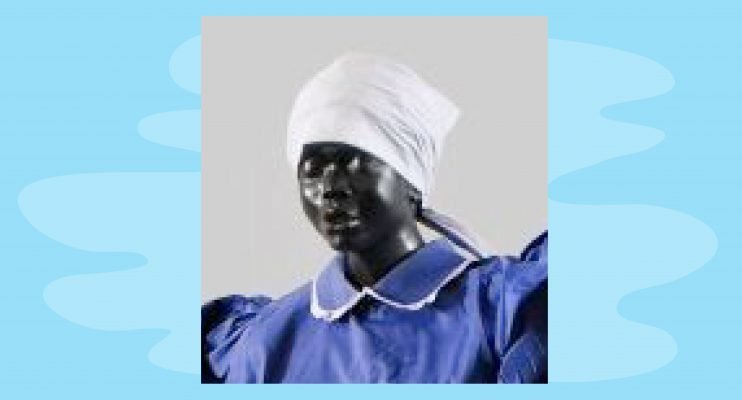
Long live the Dead Queen
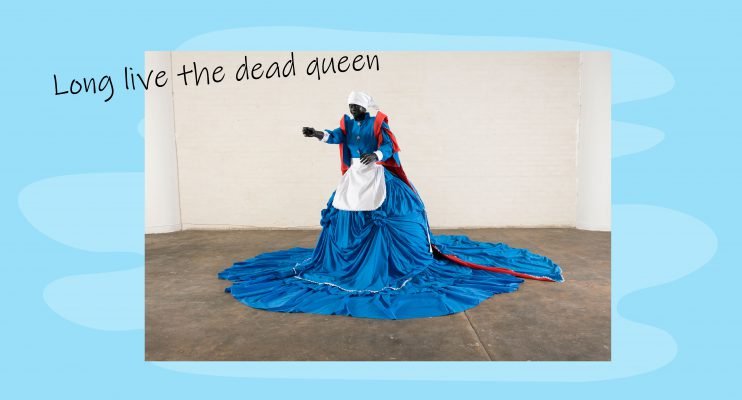
Mary’s first series with Sophie as the lead star was called Long Live the Dead Queen. These works were exhibited at the 2010 Venice Biennale. Mary Sibande also won the Standard Bank Artist of the Year award.
Long live the dead Queen was found in murals all over the City of Johannesburg in 2010 and it was amazing to see Mary literally make it this big. In these artworks we can see how Mary combines her love for fashion with fine arts.
Material also plays a very important part in Mary’s fashion choices: the original blue colour of Sophie’s outfit is reminiscent of the blue overalls worn by the South African labour. She contrasts this overall material by creating a typical Victorian maid outfit and then transforming that into a beautiful Victorian dress.
This really plays with the stereotypes placed on black woman. She is challenging them to dream again and she is sending a message of empowerment over the years.
The evolution of Sophie
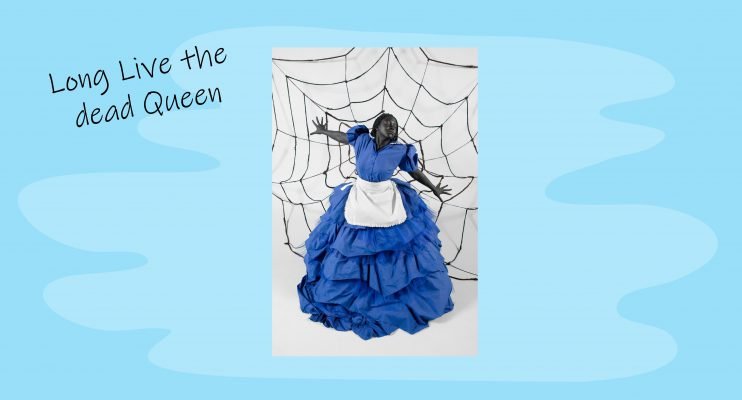
Through Mary’s work there’s an evolution that takes place within Sophie: the first series Long Live the Dead Queen she was predominantly wearing blue, in the second series The Purple shall Govern she was wearing purple.
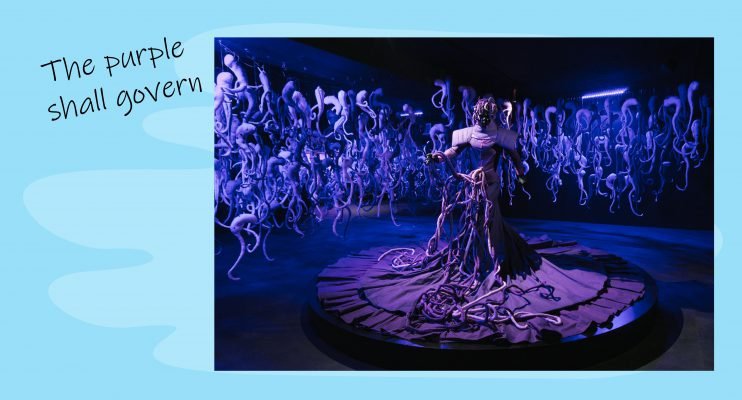
In her latest work Sophie is wearing red.
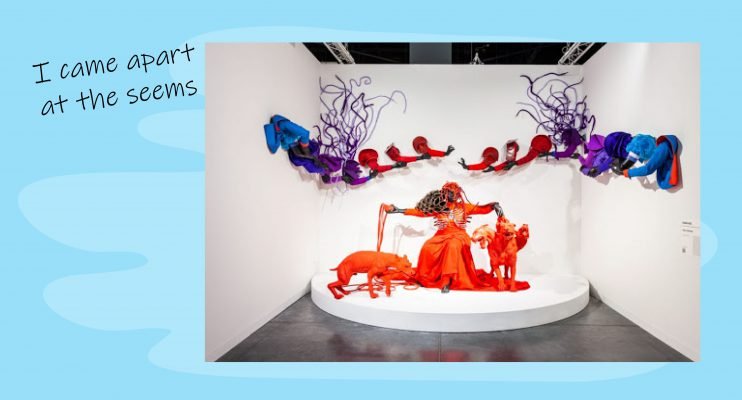
Through Mary’s work there’s an evolution that takes place within Sophie: the first series Long Live the Dead Queen she was predominantly wearing blue, in the second series The Purple shall Govern she was wearing purple, and in her latest work Sophie is wearing red.
The purple shall govern
In the second series The Purple shall Govern Sophie has been emancipated she is now queen and a leader and she’s leading this army of embryos, her children into a new future and she’s got this umbilical cord connecting her to the entire world. I
n the Apartheid regime people at protests were sprayed with purple ink to mark them so that the police could go and catch them after the protest, it’s very difficult to get this particular ink of your body but here Sophie is wearing this purple almost as armor.
It’s become a part of her identity and one of the graffiti’s that Mary Sibande saw in Soweto during the riots was “the purple shall govern”, one day they will rule South Africa and here we see Sophie being a ruler.
I came apart at the seams

In her latest works I Came Apart at the Seams we see red as a dominant colour starting to feature and in this time Mary Sibande is pregnant and she’s expecting a child. She’s thinking of all these atrocities in the world and how she can fix them and what legacy is she going to leave behind.
This red is the red of passion, this desire to change the world and she’s got all these creatures and animals doing her bidding to make the world a better place. It is the colour of blood love and passion.
In this artwork we can see that purple Sophie is pregnant she is cradling her belly she is concerned about her child being born into this world and she’s literally sending out her red dogs to go and change the world There’s a desperateness that she needs to fix the problems of the world within nine months before this baby arrives.
How does Mary do this?
When asked she predominantly thinks of herself as a sculptor but one of these artworks requires so much more – she combines sculpture, photography, design, fashion design, collage and theatrics all together.
She is a brilliant craftsman, first she creates the sculpture, the actual Sophie model, in a similar way that shop mannequins are made by first cutting her out of clay then making a cast and then filling that cast with a resin or an acrylic. The shape of the body is removed from the mold, is sanded down and given a matte powder coat black finish.
After this she starts designing the outfit for Sophie and starts sewing with painstaking detail and then all the extras surrounding.
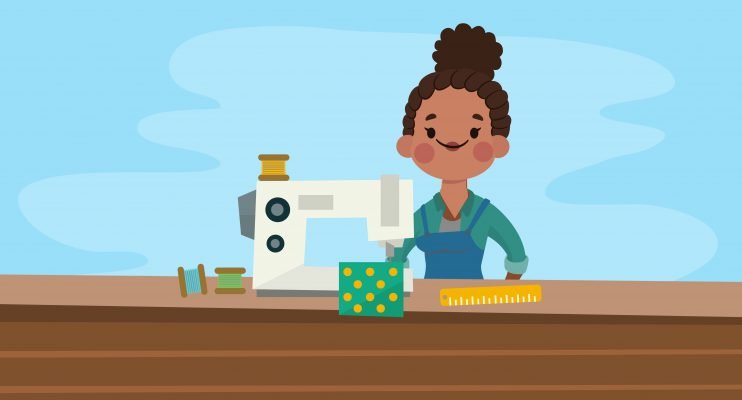
Sophie is also made, whether it’s embryos hanging from the roof or red dog sculptures charging towards the viewer. Photography also plays a major role in her art work, afterwards her beautiful installations and sculptures are photographed professionally and often exhibited with the artwork.
These photos and prints are sold and I’ve also seen them on postcards.
Which awards did she win?
Mary Sibande is an award-winning artist: in 2013 Sibanda received the Standard Bank Young Artist award, in 2014 she was given the Johannesburg alumni Dignitas award, in 2017 she was awarded the Smithsonian National Museum of African art award.
Her artworks also form part of some major collections such as the Toledo Museum of Art, the Spencer Museum of Art, the National Museum of African art in Washington.
She has had various solo exhibitions and also been a part of lots of group exhibitions. She has exhibited internationally in London, New York, Paris, Texas, Brazil, Cuba, Senegal, and Turkey.
Mary is a South African artist going from strength to strength, globally she is loved and respected because her work really, really hits a chord and discusses colonialism in a new way. Remember that colonialism didn’t just happen in South Africa but in all the colonies across our globe so there’s a lot of international communities which Sophie really resonates with.

